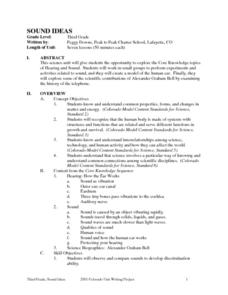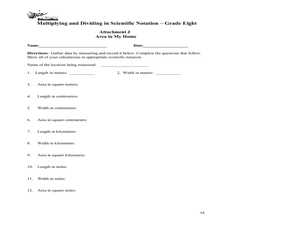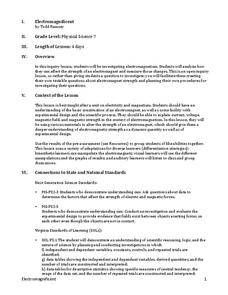Curated OER
Media Literacy Analyzed
Fourth and fifth graders define the term media literacy, then come up with examples that they share with the class. The types of media studied are auditory, visual, and written. Learners get together in pairs and perform a media...
ISTE
Let's Count to 10
Learners form groups of zero to 10 objects. They connect number names to groups, compose and decompose numbers, and use numerals to record the size of a group. The comprehensive, eight-component mini unit addresses the needs of visual,...
Curated OER
A Modest Proposal: Irony Made Understandable with Rock and Roll
Who doesn't love music? Poems and songs will engage your high school class in a discussion about irony. Use songs like "Rockin' in the Free World" or "Born in the U.S.A." to illustrate the ironic point of view. Print the lyrics so...
Perkins School for the Blind
What Do I Hear?
Being able to give positive reinforcers to a child starts with knowing what the child likes. Intended for children with blindness, this lesson gives you a way to determine the types of music your learners like best. You are given a set...
Curated OER
Nature Poems
Learners explore the visual, auditory, and verbal worlds offered by iLife applications to create a project that engages all learners and learning styles. They create a class book and CD of nature poems and artwork.
Curated OER
Who Knows the Letter?
Help learners identify initial consonant sounds and letters that represent that sound. They indicate awareness of consonant sounds and letters by responding with a physical movement. They also sing using "Sing Your Way Through Phonics"...
Core Knowledge Foundation
A Time for All Seasons - Summer
The sun is shining and the birds are singing, what better time to teach young learners about the fun season of summer. In this week-long science series, children learn how the rotation and orbit of the earth influence the days and...
Curated OER
Sound Ideas
Complete a unit of lessons on hearing and sound. Learners conduct sound experiments, research the history of the telephone and scientific contributions of Alexander Graham Bell, and create a model of the human ear.
Curated OER
Saltwater: Nifty Aqueous Colorful Layers
A classic investigation on the density of liquids is explained for you in this lesson plan. Te begin, you prepare water samples of different salinities and then add different food coloring to keep them separated and easily identified....
Curated OER
Read to Us!
Kids love being read to. Use these children's books and accompanying activities to engage young learners. Fun drawing print-outs and charts are included, and a variety of reading strategies are employed.
Ohio Department of Education
Multiplying and Dividing in Scientific Notation - Grade 8
Here is really nice set of resources on scientific notation. Eighth and ninth graders explore the concept of multiplying and dividing in scientific notation. In this multiplying and dividing numbers in scientific notation instructional...
Bright Hub Education
All about Owls
Art projects are great ways to stimulate all the senses. Learners with visual impairments create art to better grasp the concept of day and night. They'll discuss the ways they know the difference in the time of day, the animals that are...
Mobile Education Store
StoryBuilder for iPad
Invite your kids to tell all sorts of stories with this interactive app. Learners view images and record their own voices as as they create short narratives to go along with the images. The app provides plenty of customizable scaffolding...
PBS
Harriet Beecher Stowe: Author and Abolitionist
Scholars use primary documents, video clips, and legal decisions to uncover Harriet Beecher Stowe's motives for writing Uncle Tom's Cabin. They create a 21st century book jacket for the novel to capture the purpose behind Stowe's story.
PBS
Harriet Tubman: Abolition Activist
Imagine breaking out of prison only to continue to go back in to get others out. Welcome to the life of Harriet Tubman. Scholars research her amazing life and her impact on abolition in the United States. Using primary and secondary...
Film Space
Whale Rider
Ready for an educational movie day? Use a resource based on the movie Whale Rider to learn more about the Maori culture. Class members answer a variety of questions and listen to music from the soundtrack to further analyze and...
Smithsonian Institution
War of 1812
Luckily for those who aren't history buffs, anyone can guess that the War of 1812 happened in ... 1812. But how to cover the rest of the story? The resource does just that with effective direct instruction that includes statistics,...
Curated OER
Future Actions
How do you conjugate a reflexive verb? This plan suggests reading a children's book to your intermediate Spanish speakers. Follow the reading with a PowerPoint slide show that presents reflexive verbs, a sentence using the verb, and a...
Inclusive Technology
Finger Paint With Sounds
Finger painting is fun, but finger painting with sounds is really fun. Finger painting is important for many reasons, it can help children develop a sense of creativity, foster social skills and emotional skills, it helps develop large...
Illustrative Mathematics
Counting by Tens
With this daily counting activity, your kindergartners will master counting in sequence automatically from 0 to 100, and will count in multiples of ten to 100. With the whole class, count to 100. With each number, learners will whisper...
STEM for Teachers
Electromagnificent
This physics pun really hertz, but this STEM lesson plan can help. The inquiry-based activity has young scientists create a testable question about electromagnetic strength; plan and implement their own experiments; and record and...
Curated OER
Move the Sounds
Use cut out letters to make beginning sounds, blends, and word families that ultimately make new words. Learners move around physically as they hold the letters to make the specified blend or word. Assessment suggestions are included.
Curated OER
The Day After Tomorrow: How is the Density of Water Related to Climate Change and Global Warming?
Science learners simulate what happens when ice breaks up and floats on water and how increased pressure on ice causes it to melt faster. They view a clip from the movie, The Day After Tomorrow, and relate their lab activities to what...
Curated OER
Air, Air Everywhere! Lesson 2: Acid Rain
Middle school environmentalists record the pH of four different liquids, including two aerosol cleaning products. They liken the products to acid rain and speculate in writing which might affect the human respiratory system. Although...

























